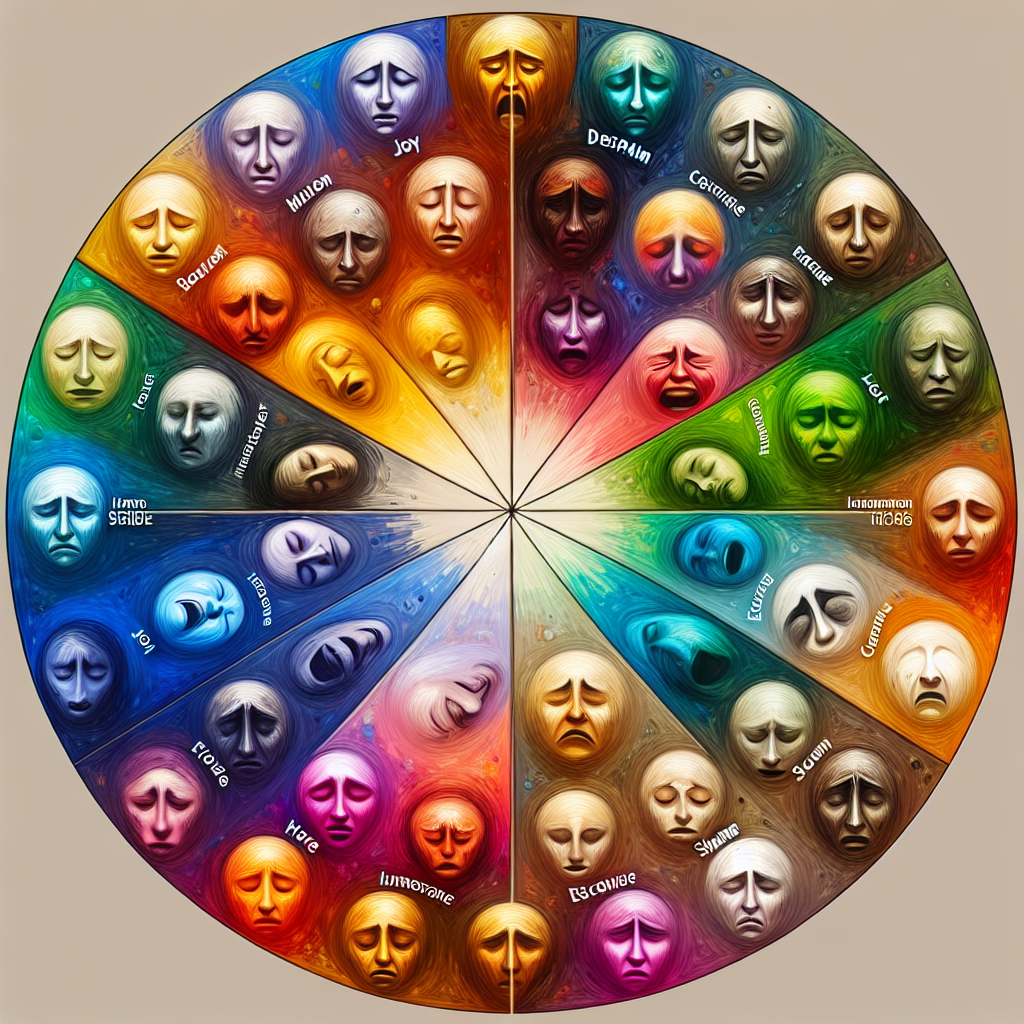Imagine a world where you have the ability to identify and understand every emotion you encounter. From the subtle nuances of happiness to the depths of despair, being equipped with a vocabulary of emotions unlocks a world of self-awareness and empathy. In this article, we explore the concept of the 21 emotions, delving into their significance and how they shape our daily experiences. So, buckle up and get ready to embark on a journey of emotional discovery that will leave you with a newfound appreciation for the intricacies of the human psyche.
Understanding Emotions
Emotions play a significant role in our daily lives, shaping our thoughts, behaviors, and overall well-being. They are the internal experiences that color our interactions with the world around us, offering insight into how we perceive and respond to various situations. By understanding emotions, we can develop better self-awareness, navigate relationships more effectively, and cultivate emotional intelligence. In this article, we will explore the definition, importance, and various types of emotions, providing a comprehensive understanding of this fascinating aspect of human experience.
Definition of Emotions
Emotions can be described as complex psychological and physiological responses to stimuli, both internal and external. They encompass a wide range of feelings and can be experienced as brief or long-lasting sensations. Emotions involve subjective experiences that are influenced by personal beliefs, cultural norms, and individual perspectives. They are not solely restricted to thoughts or physical sensations but are a holistic expression of our internal states.

Importance of Emotions
Emotions play a crucial role in how we perceive and interpret the world around us. They provide valuable information about our needs, desires, and preferences, guiding our decision-making processes. Emotions also serve as a form of communication, allowing us to express ourselves and connect with others on a deeper level. By understanding our own emotions and recognizing those of others, we can foster healthier relationships and enhance our social interactions. Furthermore, emotions contribute to our overall well-being, influencing our mental, emotional, and even physical health.
Types of Emotions
Emotions can be broadly categorized into primary emotions, secondary emotions, positive emotions, negative emotions, complex emotions, social emotions, self-conscious emotions, cognitive emotions, and physiological emotions. Let’s explore each of these categories in more detail, highlighting the specific emotions that fall under each.

Primary Emotions
Primary emotions are the most basic and universal emotions that humans experience. They are instinctual and hardwired in our biology. The primary emotions include joy, sadness, anger, and fear.
Joy
Joy is an intense feeling of happiness and delight. It is often associated with moments of elation, such as achieving a goal, receiving good news, or experiencing a pleasant surprise. Joy brings about a sense of well-being, contentment, and positive energy.
Sadness
Sadness is a feeling of unhappiness or sorrow. It can arise from various sources, such as loss, disappointment, or loneliness. Sadness often manifests as tears, a heaviness in the chest, and a general feeling of melancholy. It is an essential emotion that allows us to process and heal from difficult experiences.
Anger
Anger is a powerful emotion characterized by feelings of frustration, irritation, or rage. It arises when we perceive a threat, injustice, or violation of our boundaries. Anger can motivate us to take action, assert ourselves, and protect our rights. However, it is crucial to manage anger constructively to avoid harming ourselves or others.
Fear
Fear is an intense emotional response to potential danger or harm. It triggers the body’s fight-or-flight response, preparing us to either confront the threat or flee from it. Fear can be rational or irrational, and it can range from mild unease to debilitating anxiety. Understanding and managing fear is vital for navigating life’s challenges and maintaining a sense of safety.
Secondary Emotions
Secondary emotions are complex emotions that arise as a result of primary emotions or a combination of multiple emotions. They can vary in intensity and duration, and they often serve as protective mechanisms or coping strategies. The secondary emotions include jealousy, guilt, shame, and pride.
Jealousy
Jealousy is a feeling of envy or resentment towards someone who possesses what we desire or believe we deserve. It often stems from insecurity, fear of abandonment, or a sense of inadequacy. Jealousy can be detrimental to relationships, but understanding and addressing its underlying causes can facilitate personal growth and foster healthier connections.
Guilt
Guilt is an emotion that arises when we believe we have violated moral or ethical standards. It serves as a form of self-punishment and motivates us to make amends or change our behavior. While guilt can be helpful in guiding our actions, excessive guilt or unfounded guilt can be detrimental to our well-being. Understanding the source of guilt and distinguishing between healthy and unhealthy guilt is crucial for our emotional health.
Shame
Shame is a deeply painful emotion characterized by feelings of humiliation, disgrace, or unworthiness. It arises when we believe we have failed to meet societal or personal expectations. Unlike guilt, which focuses on our actions, shame attacks our self-worth and identity. Addressing and managing shame requires compassion, self-acceptance, and understanding that mistakes and imperfections are an inevitable part of being human.
Pride
Pride is a positive emotion that arises from a sense of accomplishment, self-worth, or recognition. It can be a motivator for personal and professional growth, as it celebrates our achievements and reinforces our confidence. However, excessive pride or arrogance can hinder our relationships and personal development. Cultivating a healthy sense of pride involves balancing self-assurance with humility and acknowledging the contributions of others.

Positive Emotions
Positive emotions contribute to our overall well-being and enhance our life experiences. They promote resilience, creativity, and social connections. The positive emotions include happiness, excitement, love, and hope.
Happiness
Happiness is a state of well-being characterized by positive emotions, satisfaction, and contentment. It is often associated with positive life events, fulfilling relationships, and a sense of purpose. Cultivating happiness involves adopting a positive mindset, practicing gratitude, and focusing on the present moment.
Excitement
Excitement is an emotion characterized by a high level of energy and anticipation. It arises when we are looking forward to something pleasurable or engaging. Excitement can enhance our motivation, creativity, and overall enjoyment of life. Embracing excitement allows us to fully immerse ourselves in new experiences and embrace the unknown.
Love
Love is a profound emotion that encompasses a deep affection, care, and attachment towards someone or something. It is a complex emotion that can manifest in various forms, such as romantic love, familial love, or platonic love. Love contributes to our emotional well-being, fosters meaningful connections, and promotes empathy and compassion.
Hope
Hope is an optimistic emotion that arises from a belief in the possibility of positive outcomes, even in challenging situations. It provides a sense of purpose, resilience, and motivation to overcome obstacles. Cultivating hope involves nurturing optimism, setting realistic goals, and maintaining a positive outlook in the face of adversity.
Negative Emotions
Negative emotions, although often perceived as undesirable, serve important functions in our lives. They act as warning signals, protect us from harm, and facilitate growth and self-reflection. The negative emotions include sadness, anger, fear, and disgust.
Sadness (already covered in Primary Emotions)
Anger (already covered in Primary Emotions)
Fear (already covered in Primary Emotions)
Disgust
Disgust is an emotion characterized by strong feelings of revulsion, repulsion, or aversion. It arises in response to something offensive, unclean, or morally repugnant. Disgust serves as a protective mechanism, preventing us from engaging with potentially harmful or contaminated stimuli. Understanding the role of disgust can help us make informed decisions and maintain our well-being.

Complex Emotions
Complex emotions are multifaceted and often arise from a combination of primary and secondary emotions. They can be challenging to decipher and manage due to their nuanced nature. The complex emotions include ambivalence, anxiety, awe, and confusion.
Ambivalence
Ambivalence is a state of conflicting emotions or beliefs towards a person, situation, or decision. It involves experiencing both positive and negative emotions simultaneously, creating a sense of internal conflict. Ambivalence can arise when we are torn between different options, values, or desires. Acknowledging and exploring ambivalence can lead to better decision-making and personal growth.
Anxiety
Anxiety is a pervasive feeling of fear, worry, or unease that often lacks a specific cause. It can range from mild to debilitating and is accompanied by physical symptoms like restlessness, increased heart rate, and tension. Anxiety can be triggered by various factors, such as stress, trauma, or a particular phobia. Managing anxiety involves various strategies, including self-care, relaxation techniques, and seeking professional help if necessary.
Awe
Awe is a powerful emotional response to something vast, extraordinary, or awe-inspiring. It involves a feeling of overwhelming wonder, reverence, or admiration. Awe often arises in the presence of natural wonders, great achievements, or profound experiences. Cultivating awe can enhance our sense of connectedness, inspire creativity, and foster a deeper appreciation for the world around us.
Confusion
Confusion is an emotional state characterized by a lack of clarity or understanding. It can arise when faced with complex information, contradictory opinions, or unfamiliar situations. Confusion often precedes learning and growth, as it motivates us to seek clarification and expand our knowledge. Embracing confusion and seeking knowledge can lead to personal development and a better understanding of ourselves and the world.
Social Emotions
Social emotions emerge within the context of our interactions with others. They shape our relationships, empathy, and ability to understand and navigate social dynamics effectively. The social emotions include empathy, admiration, contempt, and resentment.
Empathy
Empathy is the ability to understand and share the feelings and perspectives of others. It involves placing ourselves in someone else’s shoes, recognizing their emotions, and responding with compassion. Empathy enhances our interpersonal connections, fosters cooperation, and promotes a sense of belonging.
Admiration
Admiration is an emotion characterized by respect, appreciation, or regard for someone’s qualities, achievements, or virtues. It arises when we recognize and value the positive attributes or actions of others. Expressing admiration can strengthen relationships, motivate personal growth, and inspire us to emulate admirable qualities.
Contempt
Contempt is a strong negative emotion that arises from a perceived sense of superiority or disdain towards others. It involves a combination of anger, disgust, and moral judgment. Contempt can be damaging to relationships and hinder empathy and understanding. Recognizing and addressing contempt within ourselves is essential for fostering healthier connections.
Resentment
Resentment is a feeling of bitterness, anger, or indignation resulting from a perceived injustice, unfair treatment, or being wronged. It involves holding onto negative emotions towards those we believe have harmed us. Resentment can be detrimental to our well-being, preventing forgiveness and hindering personal growth. Letting go of resentment and finding healthy ways to address grievances are crucial for our emotional health.

Self-Conscious Emotions
Self-conscious emotions arise from our evaluation of ourselves and our actions in comparison to societal expectations, standards, or personal values. They influence our self-perception and can shape our behavior and decision-making. The self-conscious emotions include embarrassment, shame, guilt, and pride.
Embarrassment
Embarrassment is an uncomfortable emotion that arises when we perceive ourselves as being socially awkward, clumsy, or foolish. It involves blushing, avoiding eye contact, or feeling a desire to hide. Embarrassment is a universal experience and can be an opportunity for self-reflection, humility, and personal growth.
Shame (already covered in Secondary Emotions)
Guilt (already covered in Secondary Emotions)
Pride (already covered in Secondary Emotions)
Cognitive Emotions
Cognitive emotions emerge from our thoughts, perceptions, and interpretations of the world around us. They influence our judgment, curiosity, and problem-solving abilities. The cognitive emotions include surprise, curiosity, confusion, and suspicion.
Surprise
Surprise is an emotional response to an unexpected event, situation, or circumstance. It involves a sudden shift in our attention and can range from positive to negative emotions. Surprise can enhance our memory, curiosity, and adaptability, as it prompts us to explore and reevaluate our expectations.
Curiosity
Curiosity is an innate desire to seek knowledge, explore, and understand the world around us. It involves a sense of wonder, inquisitiveness, and a thirst for learning. Curiosity stimulates our cognitive abilities, creativity, and problem-solving skills. Embracing curiosity allows us to expand our horizons, challenge assumptions, and experience personal growth.
Confusion (already covered in Complex Emotions)
Suspicion
Suspicion is a cognitive emotion characterized by distrust, skepticism, or doubt towards others’ intentions or actions. It arises from a perceived discrepancy between someone’s words, behaviors, and our expectations. While suspicion can protect us from potential harm, excessive suspicion can damage relationships and hinder trust. Finding a balance between healthy skepticism and trust is crucial for healthy social interactions.
Physiological Emotions
Physiological emotions manifest in our physical body and are associated with distinct physiological responses. They are closely interconnected with our psychological experiences and can influence our overall well-being. The physiological emotions include arousal, relaxation, tension, and euphoria.
Arousal
Arousal is a physiological and psychological state involving heightened alertness, energy, and responsiveness. It can be associated with excitement, stress, or anticipation. Arousal prepares our body and mind for action, enabling us to focus and respond effectively to stimuli.
Relaxation
Relaxation is a state of physical and mental calmness, free from stress or tension. It involves reduced physiological arousal, ease of muscles, and a general sense of tranquility. Relaxation is essential for maintaining overall well-being, managing stress, and promoting restorative sleep.
Tension
Tension refers to a state of physical and psychological strain or stress. It often arises from excessive demands, worries, or conflicts. Tension can manifest as muscle tightness, headaches, or irritability. Managing tension involves stress reduction techniques, self-care, and effective coping mechanisms.
Euphoria
Euphoria is an intense and overwhelming feeling of happiness, ecstasy, or elation. It is often associated with peak experiences, such as achieving a goal or experiencing something extraordinary. Euphoria leads to heightened pleasure, increased energy, and an enhanced sense of well-being.
In conclusion, emotions are an integral part of the human experience, influencing our thoughts, actions, and overall well-being. By understanding and embracing our emotions, we can cultivate greater self-awareness, enhance our relationships, and develop emotional intelligence. The various types of emotions, including primary, secondary, positive, negative, complex, social, self-conscious, cognitive, and physiological emotions, offer a comprehensive framework for exploring and navigating our emotional landscape. It is important to remember that emotions are not good or bad; they simply serve as valuable messengers guiding us through our lives.

